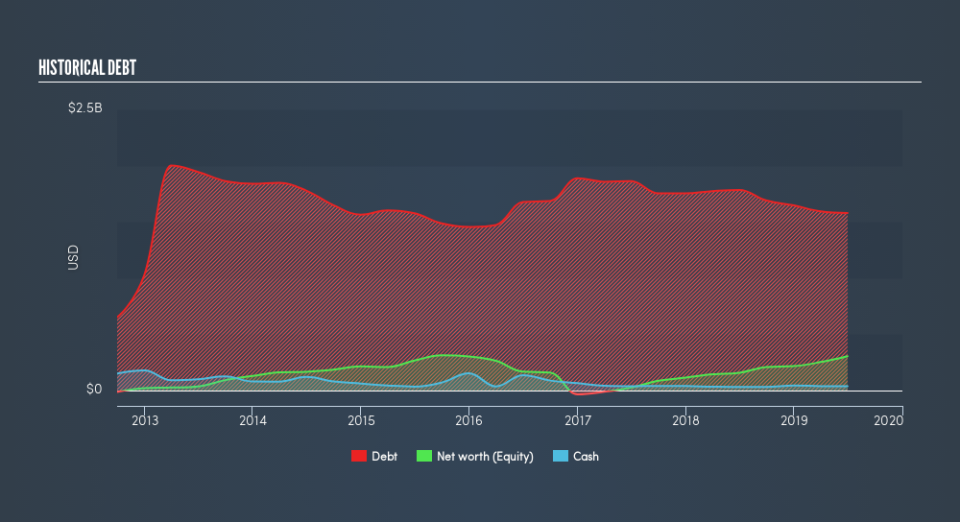These 4 Measures Indicate That Tempur Sealy International (NYSE:TPX) Is Using Debt Extensively

David Iben put it well when he said, 'Volatility is not a risk we care about. What we care about is avoiding the permanent loss of capital.' So it might be obvious that you need to consider debt, when you think about how risky any given stock is, because too much debt can sink a company. Importantly, Tempur Sealy International, Inc. (NYSE:TPX) does carry debt. But is this debt a concern to shareholders?
When Is Debt Dangerous?
Debt is a tool to help businesses grow, but if a business is incapable of paying off its lenders, then it exists at their mercy. Part and parcel of capitalism is the process of 'creative destruction' where failed businesses are mercilessly liquidated by their bankers. However, a more common (but still painful) scenario is that it has to raise new equity capital at a low price, thus permanently diluting shareholders. Of course, the upside of debt is that it often represents cheap capital, especially when it replaces dilution in a company with the ability to reinvest at high rates of return. The first step when considering a company's debt levels is to consider its cash and debt together.
View our latest analysis for Tempur Sealy International
What Is Tempur Sealy International's Debt?
You can click the graphic below for the historical numbers, but it shows that Tempur Sealy International had US$1.58b of debt in June 2019, down from US$1.78b, one year before. However, it also had US$38.3m in cash, and so its net debt is US$1.54b.
How Healthy Is Tempur Sealy International's Balance Sheet?
According to the last reported balance sheet, Tempur Sealy International had liabilities of US$738.7m due within 12 months, and liabilities of US$2.00b due beyond 12 months. Offsetting this, it had US$38.3m in cash and US$386.3m in receivables that were due within 12 months. So its liabilities total US$2.32b more than the combination of its cash and short-term receivables.
While this might seem like a lot, it is not so bad since Tempur Sealy International has a market capitalization of US$4.36b, and so it could probably strengthen its balance sheet by raising capital if it needed to. However, it is still worthwhile taking a close look at its ability to pay off debt.
We measure a company's debt load relative to its earnings power by looking at its net debt divided by its earnings before interest, tax, depreciation, and amortization (EBITDA) and by calculating how easily its earnings before interest and tax (EBIT) cover its interest expense (interest cover). This way, we consider both the absolute quantum of the debt, as well as the interest rates paid on it.
Tempur Sealy International has a debt to EBITDA ratio of 4.2 and its EBIT covered its interest expense 3.1 times. This suggests that while the debt levels are significant, we'd stop short of calling them problematic. Notably, Tempur Sealy International's EBIT was pretty flat over the last year, which isn't ideal given the debt load. The balance sheet is clearly the area to focus on when you are analysing debt. But it is future earnings, more than anything, that will determine Tempur Sealy International's ability to maintain a healthy balance sheet going forward. So if you're focused on the future you can check out this free report showing analyst profit forecasts.
Finally, while the tax-man may adore accounting profits, lenders only accept cold hard cash. So the logical step is to look at the proportion of that EBIT that is matched by actual free cash flow. Looking at the most recent three years, Tempur Sealy International recorded free cash flow of 38% of its EBIT, which is weaker than we'd expect. That's not great, when it comes to paying down debt.
Our View
While Tempur Sealy International's interest cover makes us cautious about it, its track record of managing its debt, based on its EBITDA, is no better. At least its EBIT growth rate gives us reason to be optimistic. When we consider all the factors discussed, it seems to us that Tempur Sealy International is taking some risks with its use of debt. While that debt can boost returns, we think the company has enough leverage now. In light of our reservations about the company's balance sheet, it seems sensible to check if insiders have been selling shares recently.
If you're interested in investing in businesses that can grow profits without the burden of debt, then check out this free list of growing businesses that have net cash on the balance sheet.
We aim to bring you long-term focused research analysis driven by fundamental data. Note that our analysis may not factor in the latest price-sensitive company announcements or qualitative material.
If you spot an error that warrants correction, please contact the editor at editorial-team@simplywallst.com. This article by Simply Wall St is general in nature. It does not constitute a recommendation to buy or sell any stock, and does not take account of your objectives, or your financial situation. Simply Wall St has no position in the stocks mentioned. Thank you for reading.

 Yahoo Finance
Yahoo Finance 
